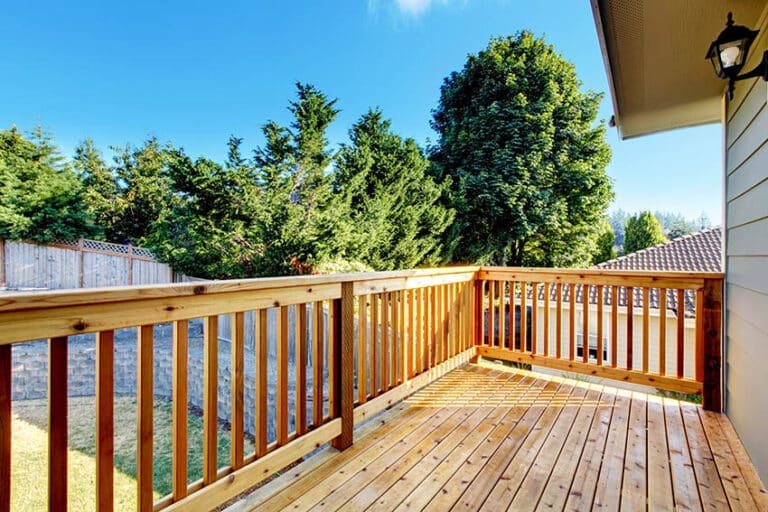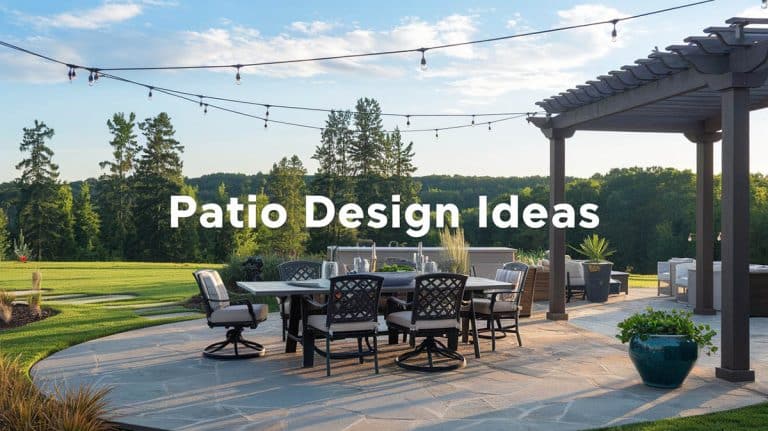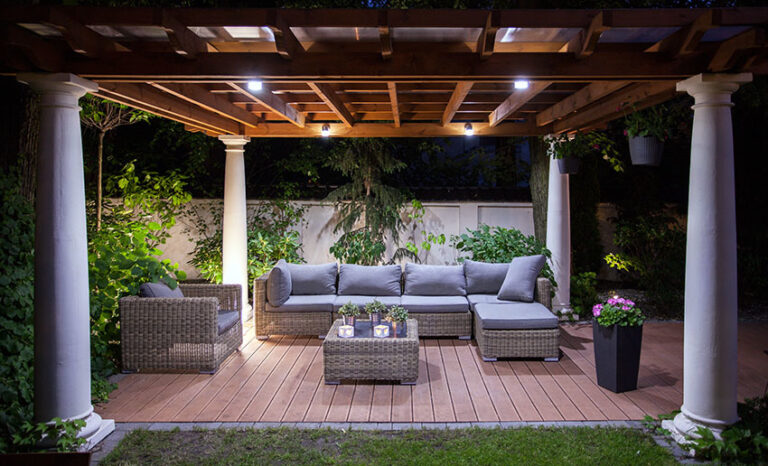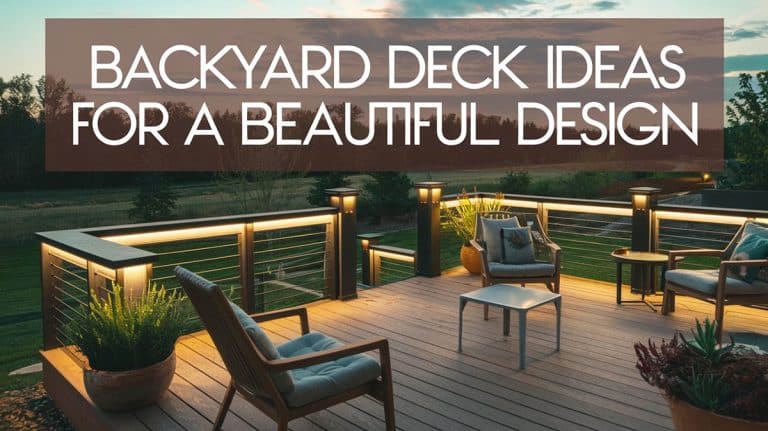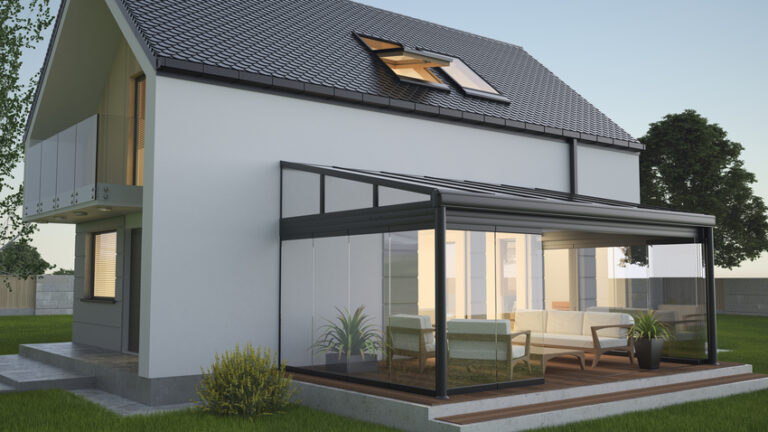What To Know About Creating Flagstone Patio Designs
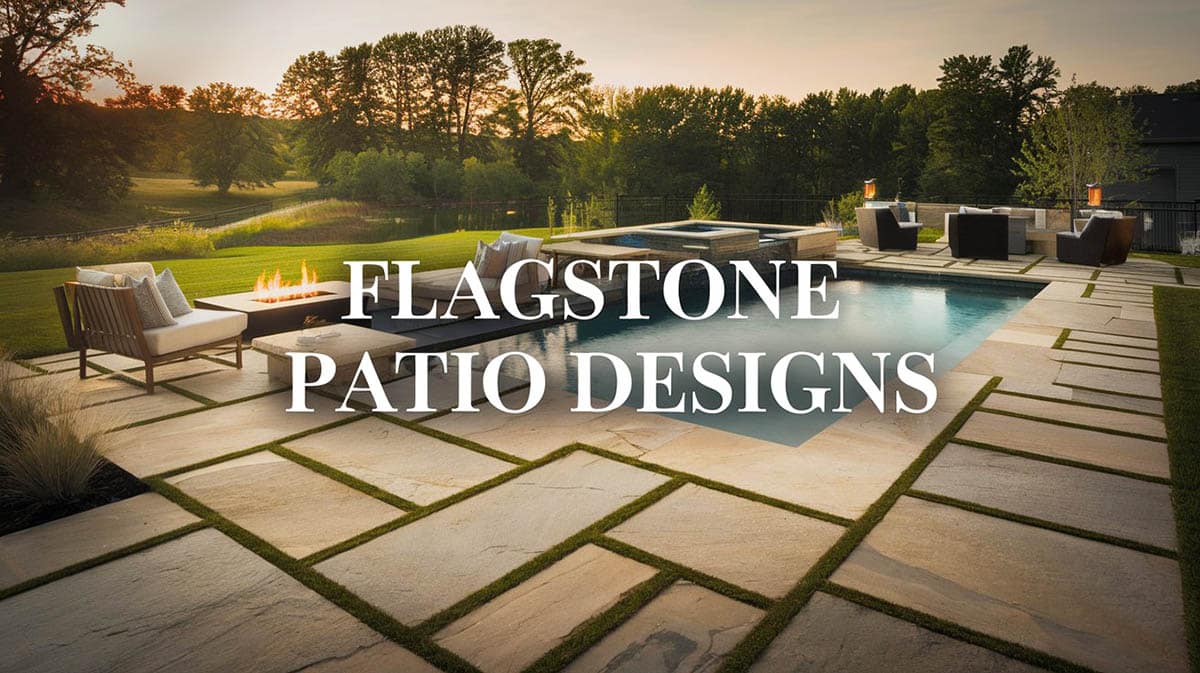
Welcome to our gallery of the best flagstone patio designs. A flagstone patio is a great way to take advantage of a yard, whether for personal relaxation or bonding with family or friends. Flagstone patios add a stunning visual element to outdoor spaces. Natural flagstones’ unique pattern and texture give off a distinct character, making patios more inviting, welcoming, and aesthetically appealing.
Below, we explore different flagstone patio designs to help you decide which is best for your home. The versatility of beige sandstone makes it a popular choice for stone patios that are both traditional and modern-inspired. The flagstone patio pictured above harmoniously blends with the deco stones of the exterior walls and built-in seating of this cozy contemporary home.
What is a Flagstone?
A flagstone patio consists of various pieces of stone laid as “flags” in a particular pattern. A flagstone is a general term for any “generic flat stone ” normally used for paving slabs, walkways, and other outdoor areas. Flagstones may be sedimentary, metamorphic, or igneous rocks consisting of layers of sand, clay, organic sediments, and other minerals. They are commonly used for patios, fences, pathways, fire pits, pool areas, walls, and roofing.
Advantages of Flagstone
Adds visual appeal to your home. Flagstones have a natural look and a unique aesthetic charm which makes it an interesting paving material for outdoor spaces.
Low maintenance. Flagstone requires little to no maintenance when installed correctly. Sweeping and adequate hosing down of water is all you need to keep it clean.
Offers a non slip surface. Unlike other materials such as outdoor tiles, flagstone is perfect for pool sides, patios and walkways. It is not slippery when wet because of its rough texture.
Boosts the value of your home. A striking flagstone patio increases the value of your home and makes it more appealing to buyers in case of resale.
Flagstone offers versatility in terms of design. Flagstones are available in a wide range of options of colors and sizes. It is suitable for both traditional and modern-inspired houses.
Flexibility in application. Flagstones can be used as paving stone materials for any outdoor space, whether a low or high-traffic area.
Cost-effective. Flagstone proves to be a wise investment because it is guaranteed to last for years. (Read on for detailed information on pricing)
Flagstone is highly durable. Compared to other materials like concrete or pea gravel, flagstone is way ahead in terms of stability and durability.
It is known for being resilient and resistant to cracking and chipping. In addition to that, it can handle the weight of additional loads like outdoor furniture.
- Resistant to moss damage and acidic soil.
- Flagstone is weather resistant. It can withstand harsh outdoor elements, extremely hot weather, and cold winters without corroding.
- Flagstone is an easy material to work with.
- Flagstone is guaranteed to last for decades.
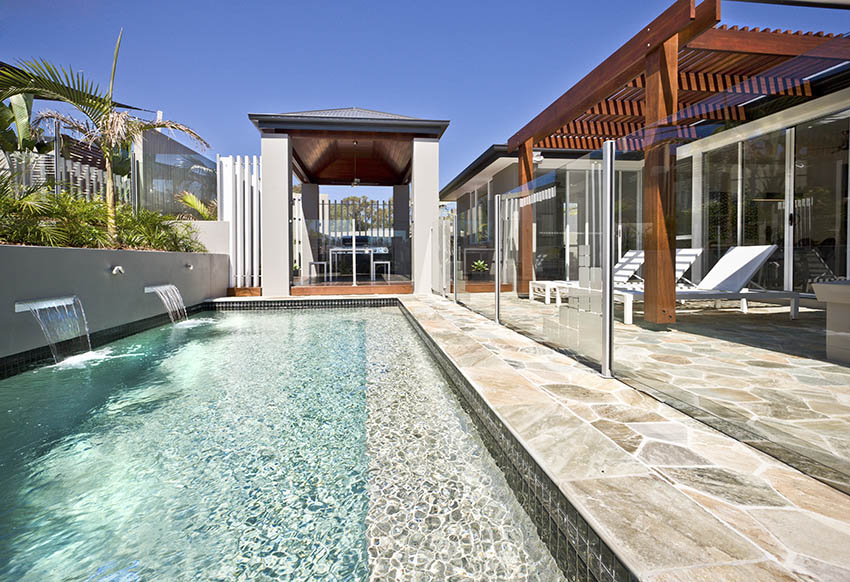
Disadvantages of Flagstone
Flagstone is porous. Flagstones are natural stones that make them inherently porous. Flagstones such as sandstone are porous and absorbent and may require treatment before use.
Uneven surface. Flagstone patio designs sometimes have uneven surfaces due to their varying size and thicknesses. This can be avoided with proper installation.
Might require additional assistance in installation. Although installing a flagstone patio is relatively easy, handling the material can be quite challenging due to its size and weight.
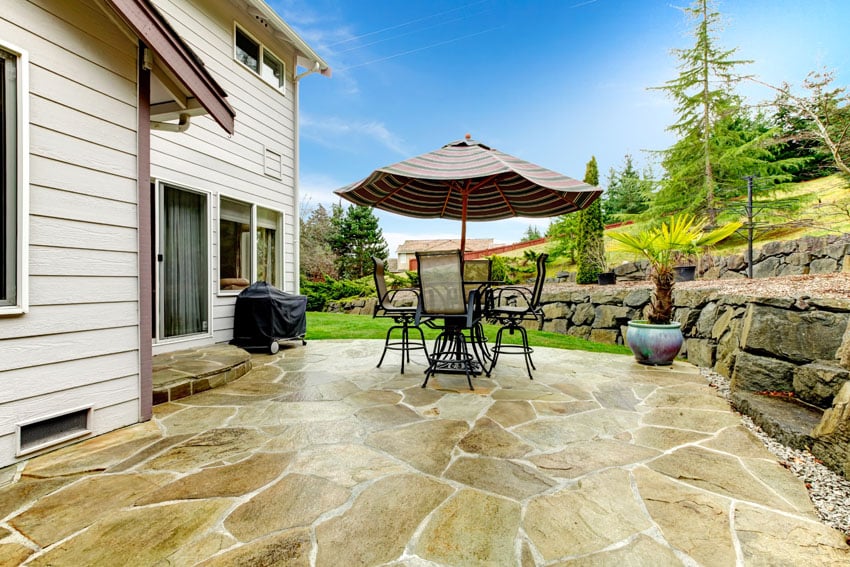
Flagstone patio designs make stunning focal points even for small outdoor spaces. The light, earthy color of travertine flagstones makes this space appear bigger.
Common Flagstone Materials
Flagstones are available in different types, sizes, shapes, and thicknesses. They come in a broad spectrum of colors, ranging from soft beige hues to rich dark colors like brown, blue, or gray. Here are some of the most common flagstone materials, their descriptions, and their positive and negative features.
Limestone
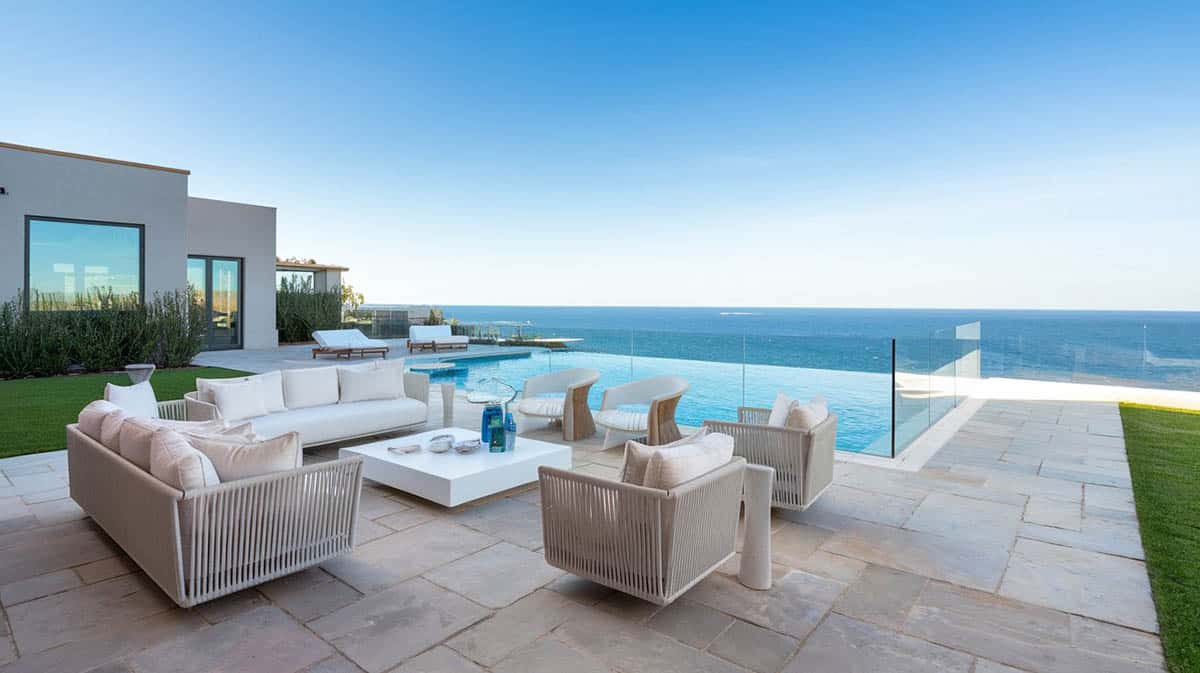
Limestone is a sedimentary rock mainly composed of calcite or calcium carbonate. It is as dense as marble and very durable and hard-wearing. Limestone is characterized by its lightly textured surface and naturally rift appearance, which is sometimes polished. Its most popular color is beige with a tinge of brown, but it is available in a myriad of colors, such as gray, yellow, and black.
Limestone is known for its insulating properties and weather-resistant features. It is highly suitable for patios in humid climates as it doesn’t get too hot during summer and won’t get cold in winter. Its drawbacks include susceptibility to damage when exposed to acid.
When specifying limestone for an outdoor patio, opt for a honed or brushed finish if you want a non‑slip surface that still showcases the stone’s subtle veining. A sealed tumbled finish, on the other hand, offers a more rustic, aged look that pairs beautifully with Mediterranean or cottage‑style gardens. Expect to pay $7–$15 per sq ft for the stone alone in most U.S. markets, plus another $10–$20 per sq ft for professional installation. Clean only with pH‑neutral stone soap—acidic or citrus‑based cleaners will etch the surface. Finally, choose pieces at least 1¼ in. thick for freeze–thaw climates to minimize the risk of cracking over the years.
Travertine
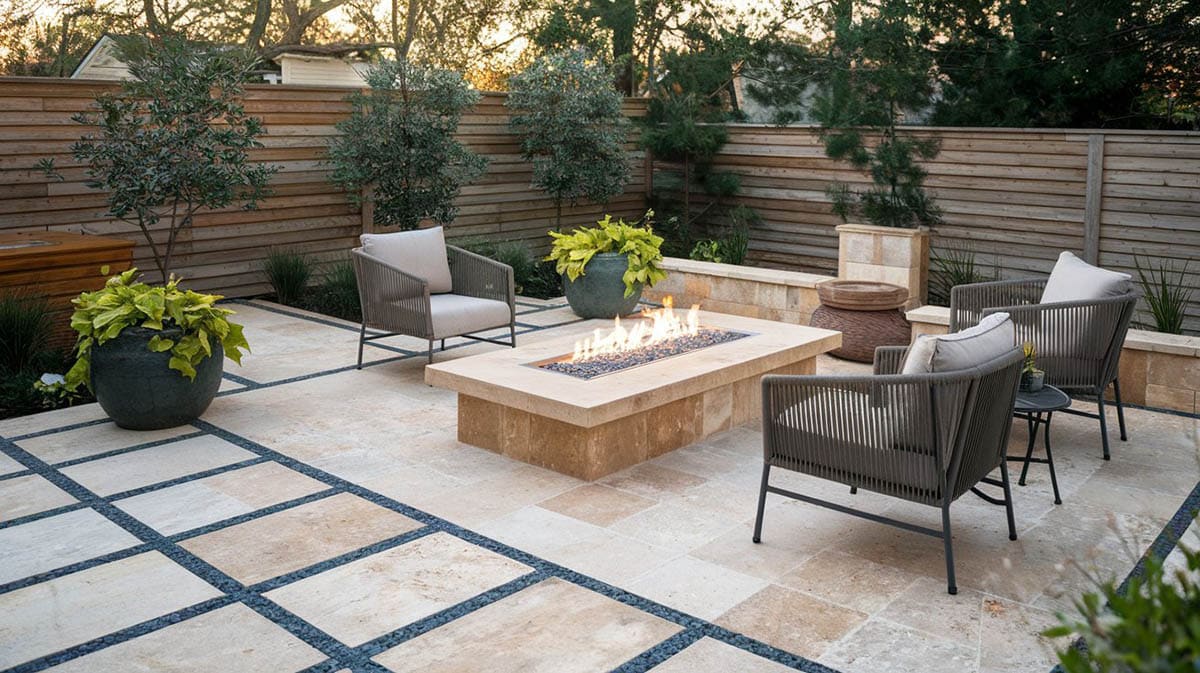
Well-loved for its luxurious appeal, this type of natural stone is a compacted variety of limestone. Known to be temperature resistant, it can endure both hot and cold weather. This makes it highly suitable as a paving material for patios and pool areas. It has a weathered appearance that is characterized by pitted holes.
Travertine is available in shades of tan, brown, and bluish-gray tones. It is considered to be very durable, but it has some downsides to it. Travertine is porous and can be hard to maintain because of the numerous holes in its surface. Since it is a type of limestone, it is also sensitive to acid stains and will break down when exposed to it.
Travertine is available in “filled” and “unfilled” varieties; filled tiles have their natural pits packed with a color‑matched epoxy or cement, giving the surface a smoother feel and making maintenance much easier. For pool decks, select a tumbled, unfilled finish—the open pores boost slip resistance when wet. Travertine typically runs $8–$18 per sq ft, with premium silver or gold selections at the upper end. Because it stays up to 20 percent cooler underfoot than concrete, it’s a favorite in hot climates. Re‑seal every 12–18 months with a penetrating stone sealer, and avoid high‑alkaline cleaners that can discolor the stone.
Sandstone
Sandstone is a warm medium-toned sedimentary rock consisting of quartz and sand. It comes in various earthy colors, ranging from soft pastels like beige and pink to darker tones like brown, dark red and yellow gold. Sandstone has a very natural appearance, making it highly preferred for contemporary applications. The thicker variety of sandstone is weather resistant. Its advantages also include retaining cool surface temperature even during hot weather. Its drawbacks include water absorption due to porosity and added maintenance, such as sealing to avoid stains.
If you’re installing sandstone in an area that receives heavy rainfall, specify a dense variety (low pore‑count) sourced from India or Australia—these absorb less water and resist freeze–thaw damage. Color variation is part of sandstone’s charm; lay out the pieces dry first so you can balance the light and dark tones for a cohesive look. Prices usually fall between $6–$12 per sq ft, although calibrated pavers (machined to a uniform thickness) cost 10–15 percent more and drastically speed up installation. Apply a breathable, water‑based sealer every two years to reduce efflorescence and make stain removal easier.
Slate
Slate is a type of fine-grained metamorphic rock that is layered with clay minerals and volcanic ash. Characterized by its flaky appearance, this antique-looking stone is a popular choice for traditional country-inspired patios. Slate stone comes in various colors, such as gray and green, with tinges of copper and rust.
This type of stone is one of the strongest natural stone flooring materials, as it is inherently resistant to chipping, cracking, breaking, and scratches. Compared to other materials, slate is more expensive and considered to be a high-end flagstone material. Its disadvantages include limited availability in large sizes and additional upkeep to maintain its appearance.
Because slate naturally cleaves into layers, always check for “rings” (weak planes) that may delaminate over time—especially in budget pallets. Premium Brazilian or Vermont slates are denser and less prone to flaking. Expect material costs in the $10–$25 per sq ft range, reflecting both grade and color rarity. In snowy regions, select a textured or “cleft” finish to maintain traction when the stone is wet or icy. Slate’s rich charcoal and multicolor hues fade slowly in UV light, but applying a color‑enhancing sealer every two to three years will keep the tones vibrant.
Basalt
Basalt is a type of volcanic rock with a lightly textured appearance and a natural grayish, black, and beige color. Its surface has natural pits, which may require additional cleaning. Because of its great insulation properties, basalt is commonly used as a flooring material for outdoor spaces like patios. Its negative features include porosity and the tendency to become dull-looking.
While basalt’s deep gray‑black palette complements contemporary designs, it can lighten if not regularly sealed—UV exposure gradually forms a soft patina. Choose a flamed or bush‑hammered finish to add slip resistance without obscuring the stone’s natural basaltic speckles. Basalt pavers start around $9 per sq ft and can hit $18 per sq ft for oversized formats. To prevent mineral deposits from rising to the surface, lay the stone on a well‑draining crushed‑rock bed rather than directly on concrete. Re‑seal annually in high‑traffic zones to protect against oil and food stains.
Quartzite
Quartzite is a type of granular metamorphic rock that is composed of quartz. It is compact, hard, and durable. Characterized by a smooth glassy appearance, it is available in different color variants such as grays, green, blue, light tan, rust, gold, and silver. Quartzite has a timeless look, making it a perfect flagstone for classic-inspired patios. It is weatherproof, long-lasting, can withstand wear and tear, and won’t corrode even when exposed to harsh chemicals.
Compared to sandstone, quartzite is more resistant to stains. However, it is likely to etch and requires additional maintenance to prevent dirt from getting stuck in its coarse textured surface. Since quartzite is also very hard, cutting it into shapes may be challenging.
Quartzite’s extreme hardness (Mohs 7) makes it an excellent choice for driveways or heavily used patios, but plan on diamond‑blade saws and high labor costs when cutting intricate patterns. Prices range from $12–$30 per sq ft, depending on color (rare blues and greens command premiums). Opt for a sand‑blasted finish if you want extra grip without losing the stone’s subtle shimmer. Quartzite rarely needs sealing for durability, yet a light penetrating sealer helps repel red‑wine or barbecue stains in entertainment areas. Use a stiff‑bristle brush—not steel wool—for routine cleaning to avoid surface scratches.
Bluestone
Bluestone is a type of sandstone that generally has a grayish-blue color and a very flat appearance with a rough texture. Other variations are rust, tan, brown, gray, purple or blue in color. Its classic appearance makes it a graceful addition to patios and outdoor living spaces. Bluestone is very dense and considered a tough paving material as it can withstand harsh winters and extreme summers.
However, it has several disadvantages. It needs to be sealed to protect it from scratches, resist stains from chlorine or salt water, and to preserve its color. Prized for its exquisite beauty, bluestone is also considered an upscale flagstone material.
True Pennsylvania bluestone is prized for its consistent blue‑gray tone but is available in “full‑color” ranges that mix rust, bronze, and lilac—ideal for homeowners seeking more warmth. This stone is sold as Natural‑cleft (textured) or Thermal‑treated (smooth, flame‑finished), with thermal pieces costing about 15 percent more. Material pricing typically starts at $8 per sq ft and climbs to $20 per sq ft for large pattern‑cut squares. In freeze–thaw zones, request pieces that are at least 1½ in. thick to reduce spalling. Apply a breathable sealer every 18–24 months, and use a pH‑neutral, non‑salt‑based de‑icer in winter to preserve the stone’s surface and color.
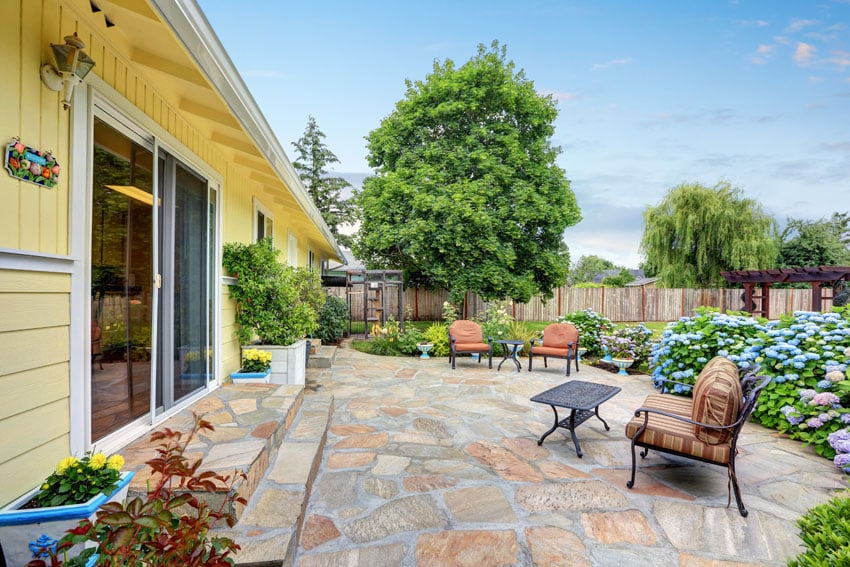
This Mediterranean-inspired patio has red flagstones that starkly contrast with the surrounding garden of hydrangeas. To balance the look of this space, metal chairs with rust-colored cushions that perfectly matched the warm color of the natural stones were added.
DIY Flagstone
DIY flagstone patios require little effort to install and can be done in as little as 2 to 3 days. Aside from using natural stone for flags, there are easier ways to create a flagstone patio. One option is to use ready-made tiles or precut paving blocks. Pre-cut stone makes assembling easier as the pieces are shaped to fit.
Another option is to use concrete tiles, which are made to look like natural stones. Texture and color are added to simulate the appearance of stones such as sandstone, slate, or limestone. On the other hand, the last option is to use stamped concrete. A stamped concrete patio is created with patterned concrete that is embossed and textured to resemble flagstones. This option is cheaper and cuts down 50% of project costs.
Flagstone Cost
The cost of installing a flagstone patio depends on several factors: the type of material or stone used, the thickness of the stone, the quantity of the stone needed, the amount of square footage to be covered, and the amount of labor. Among the types of flagstone materials discussed earlier, bluestone is considered to be the most expensive, while sandstone is one of the most affordable options.
When it comes to thickness, thicker stones are naturally more expensive because they are more durable. This will depend greatly on your project type since high-traffic areas such as patios and walkways need flagstones that are 3 inches thick. Aside from the actual stone, consumables and base materials such as sand and gravel must also be factored into the project’s cost.
The location of a project may also significantly influence the amount of materials. For items that will be shipped from a far distance, an additional amount is placed on top of the regular price.
Regarding labor costs, flagstones with irregular shapes are more expensive to install because of the added effort required to fit them together. Matching irregular stones, like custom-cut flagstones, is cheaper to install.
Another price factor to remember when installing flagstone patios is the “allowance” for the number of materials. Flagstones are natural materials, and their sizes, colors, and shapes are highly variable. Thus, a specific amount of contingency is needed to ensure that the project can accommodate these changes.
Some contractors usually include a 25% allowance for the estimated materials. To give you an idea, these unforeseen circumstances are usually caused by mismatched stones or damage during handling. Also, this will ensure a sufficient supply of stones to complete the project.
The total cost of installing a flagstone patio typically averages $15 to $30 per square foot. On the other hand, a whole flagstone patio installation project usually costs $700 to $5000 per lot, including professional installation charges.
The actual stone usually costs $3 to $5 per square foot. You can also buy the stone in bulk or in tons if you need to cover about 80 to 200 square feet to save on costs. Actual stones typically cost anywhere from $150 to more than $700 per ton.
It is also important to know that once your flagstone patio is installed, additional treatment is needed to ensure the longevity of its life and the consistency of its appearance.
Periodic sealing and application of stain is needed every 1 ½ years to 3 years to keep your flagstone patio well protected. This usually costs an additional $30 to $60 per quart or $100 to $200 per gallon of sealer. Since flagstone is considered expensive, some homeowners try to reduce costs by mixing natural stones with cheaper paving materials such as concrete, pavers or bricks.
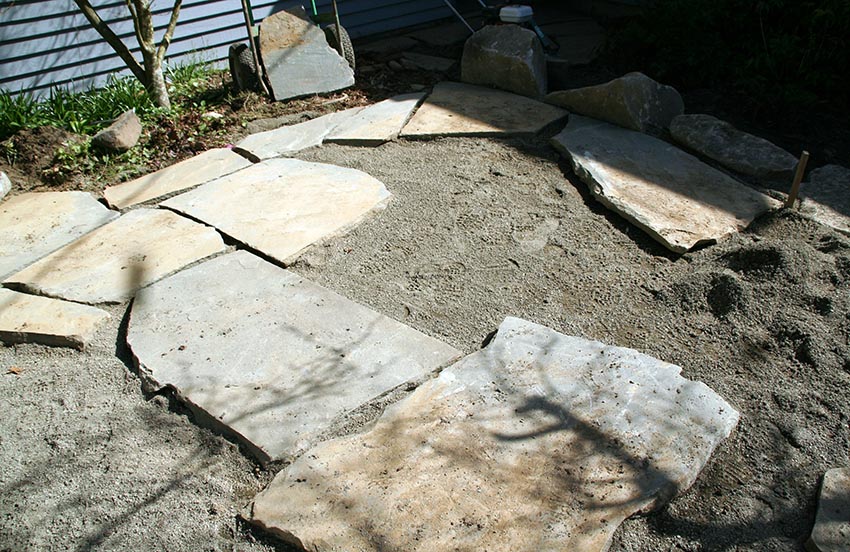
How to Build a Patio Made of Flagstone
If you want to upgrade the pavement material of your patio but would want to save on labor costs, then DIY’ing it is your best bet. Laying a flagstone patio will take about 48 hours to complete. The real challenge in this project is not the process it entails but the effort to carry big heavy stones.
Before potentially engaging in your “Do it Yourself Patio,” here are some guidelines and tips which you can keep in mind:
1. Construction Method – There are two methods of laying flagstones for pathways, walkways or patios. The first one is the “Dry Laying Technique”, otherwise known as the dry construction method, which is characterized by simply laying flagstone pieces in a bed of sand and gravel without using mortar and concrete.
This DIY process is appropriate because it reduces time and effort and eliminates the need to prepare cement and wait for the additional curing time to elapse.
It’s a good idea, according to StonePlus to use large flagstones on the perimeter of your walkway, or patio design to create stability. Applying mortar to the stones will help prevent rocking and wobbling from occurring when stepped on.
The second method, “Mortared Construction” or wet construction, is the exact opposite of the first method, wherein pieces of flagstone are permanently set with mortar to a base of gravel, sand or concrete slab.
The joints are then filled with more mortar, sand, fine gravel, or grout. Wet construction is more permanent compared to dry construction but it requires additional upkeep, such as regularly adding sand to joints. Landscape Supply has provided a PDF checklist of the tools needed to complete a flagstone mortar construction.
Dry construction is an easier method but its drawbacks include the tendency of constant readjustment and movement between the pavers.
2. Choosing your Stone – Flagstones come in different shapes and sizes. Each of these factors must be considered when deciding what type of stone to use for your project.
One key tip to consider is to always choose your flagstone about its intended purpose – whether it will be used in patios with furniture or a high-traffic area.
• Thickness – The typical thickness of flagstones is usually ¾ inches to 3 inches. Thin stones tend to crack under weight, making them inappropriate for high-traffic areas. They are also usually installed over an existing concrete slab.
Flagstones thicker than 2 inches are suitable for heavily used walkways and patios with an entertainment area. Although more expensive and much heavier, it can guarantee stability and durability.
• Stone Size – Larger and flatter stones are perfect for high-traffic areas, especially if you plan on setting up an outdoor living area in your patio. Also, when bigger flagstones are used, less “puzzling” is required. Smaller and more irregular flagstones are better for small gardens.
• Spacing and Layout – If aiming for a more formal look, use flagstones which are more consistent and similar in shape. No flagstone is exactly alike because each piece has a different shape, so you can only choose a close match but not a perfect match. Irregular flagstones, on the other hand, evoke informality.
Also, you can use smaller gaps in between flagstones if you plan on putting outdoor furniture in your patio because it is more compatible for the legs of a table or a chair. Closer flagstones also have a clean look. If you want to put ground cover in between the flagstones, you may opt to use more adequate amount of gaps.
• Type of Joints – There are 2 types of joints for flagstone pavers, the random joint and the consistent joint. Random joints use the natural edges of the stone; this usually creates 1/2 to 3 inches spacing and is ideal if aiming to achieve a rugged look.
Consistent joints, on the other hand, are shaped edges that usually create a ½ inch to ¾ inches spacing. An angle grinder is used to achieve the desired shape. This type is more suitable for achieving a more elegant and formal look.
• Color of the Stone – No general rule exists in choosing the right flagstone color for your patio. You can select according to your taste and preference in style.
Slate, for example, has a greenish-gray color, making it appropriate for contemporary patios. Sandstone has soft pastel colors that give out a traditional old-world feel, while quartzite has warm earthy tones perfect for Mediterranean-inspired patios.
Also, to ensure proper color matching, it is suggested that an allowance in quantity is added when buying your flagstones. It can sometimes be difficult to get the exact shade and match if ordering in different batches.
• Joint Fillers – Filling material is placed in between the joints of flagstones to ensure that they are firmly kept in place and to avoid movement. Materials that can be used as fillers are grout, mortar, pea gravel, sand, compactable gravel, and gator dust.
Pea gravel is small pebbles or river stones, while compactable gravel is finely crushed granite. Gator dust is a mixture of polymer binders and gravel which hardens when applied.
Building your Flagstone Patio
• Slope or Grading of the Patio – Always build your flagstone patio at a slight angle so it drains off when rainwater comes. You wouldn’t want a puddle stuck in the middle of it, so ensure it is not perfectly leveled. If the patio is placed against a house, it must be sloped directly away for drainage.
• Existing Condition of the Soil – Before setting up your flagstone patio, check the soil in your yard first. For “wet soil” yards, excavate deeper for additional drainage and a better foundation.
• Handling of Materials – Flagstones are heavy and may require additional assistance in terms of handling. Although building a flagstone patio can be accomplished by one person, it is always better to get a helping hand in dealing with the “back-breaking” work. Always use safety items such as goggles and gloves.
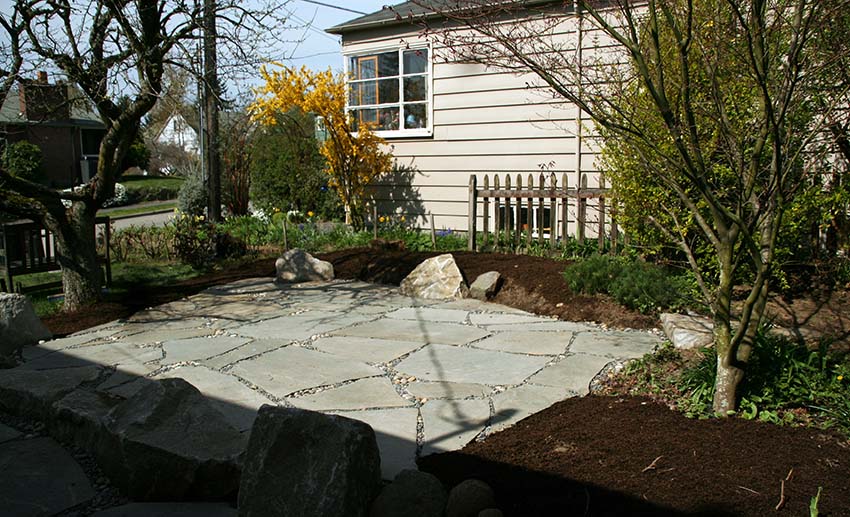
How to Lay Flagstone
• What you’ll need:
Flagstones (of your choice)
Sand (builder’s sand or polymer sand)
Gravel
String
Wooden stakes
Landscape fabric
Galvanized nails
• What you’ll use:
Measuring tape
Carpenter’s level
Trowel
Shovel
Rake
Tamping tool
Rubber mallet
Hammer
Saw
Broom
Garden Hose
Protective eyewear or goggles
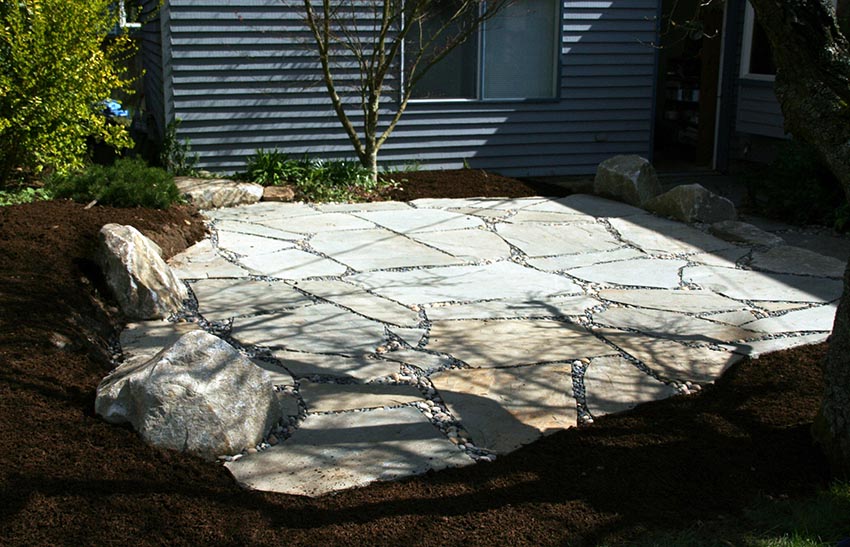
Flagstone Dry Laying Technique
• Preparation. Determine the layout, shape and size of your patio. Before anything else, measure the area of your patio using a tape measure.
Mark the length and width using stakes. Then tie a string between the stakes to connect them. Double-check if you get the exact layout, remeasure for the right size then adjust if needed.
• Determine the depth of excavation you will need. To know the depth of the pit you need to make for your patio, add 6 inches to the thickness of your flagstone (4 inches compacted base + 2 inches sand + thickness of flagstone).
For example, if using pieces of stone • which are 2 inches thick, you need to dig 8 inches deep into the ground. The finished height of your flagstone patio must be leveled with the existing yard.
This can be checked using a carpenter’s level placed on a plank within the excavation. To facilitate proper drainage, an adequate depth of 8 inches is sufficient.
• Excavate the area. Using a spade, dig 8 inches deep around the perimeter of your proposed patio. Once the layout is complete, use a shovel to dig out all the soil according to the required depth.
• Tamp down the soil. Use a garden hose to moisten the soil and then compact it firmly with a tamping tool.
• Set the landscape fabric. Lay landscape fabric on top of the soil base for your flagstone patio. This will block and prevent weeds from growing later on.
• Add base material. Fill the hole with 4 inches of base material, such as gravel or crushed limestone. This will help prevent the flagstones from moving once they are fully set. A solid foundation must be compacted well, so tamp down firmly.
Also, the deeper the base, the lesser the shifting is likely to occur during cold winter. If you prefer to add more base material, adjust the excavation depth before this step.
• Add sand. Using a rake, put a layer of 2 inches of sand on top of the gravel base. Sand will help with drainage and provides an easier way to level and position the flagstone pieces.
Builder’s sand or polymer sand may be used for this. However, polymer sand is highly recommended because it is like mortar when wet, providing a firmer base for the pavers.
In addition to that, it suppresses weed growth and won’t wash off during the rain. Tamp down the sand using a tamping tool.
• Lay paving materials. Lay down the flagstone pieces over the layer of sand. This is a tedious task because the stones need to fit together. It’s almost like solving a puzzle, so do not hurry through this step and be patient.
You may either lay all the flagstones on the ground, cut them first into shapes then level them or another method is to lay the stones fit them together then cut or adjust the shapes as you go. Start with the perimeter of your patio.
Place larger stones outside because smaller ones tend to shift after some time. Next is to set a piece of stone at the center and work towards the perimeter. As the flagstones are set piece by piece, tamp it down gently using a rubber mallet to secure them.
• Fill the spaces or the gaps. Fill the spaces in between the flagstones with sand or pea gravel. Sweep off excess material using a broom, then soak the joints with water to settle the material onto it.
Patio Ideas Using Flagstone
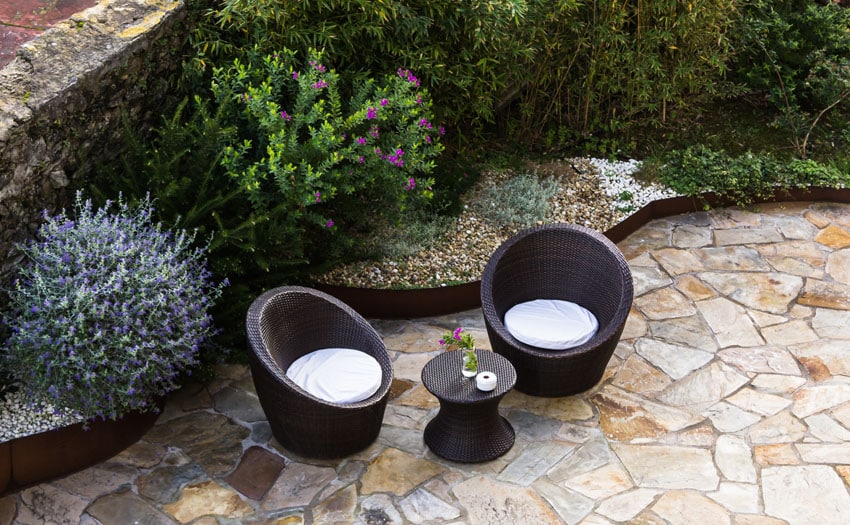
Flagstone flooring adds drama and depth to outdoor living spaces. This patio’s contemporary vignette looks cozy and inviting, accentuated by irregularly shaped sandstone and a pea gravel garden.
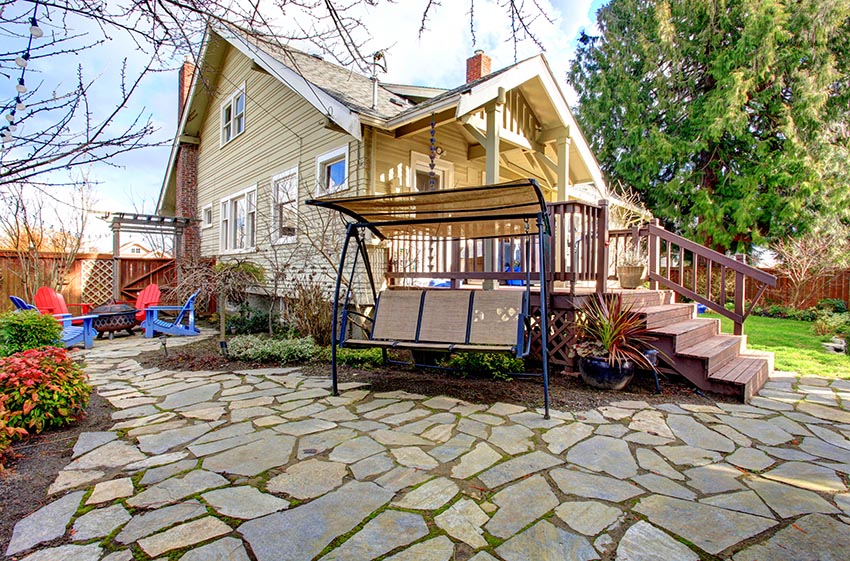
Large flat slate flagstones give life to this cozy relaxation spot, beautifully positioned in the front yard of this country-inspired home. Bright-colored outdoor chairs and a matching, swinging chair contribute to the welcoming feel of this space.
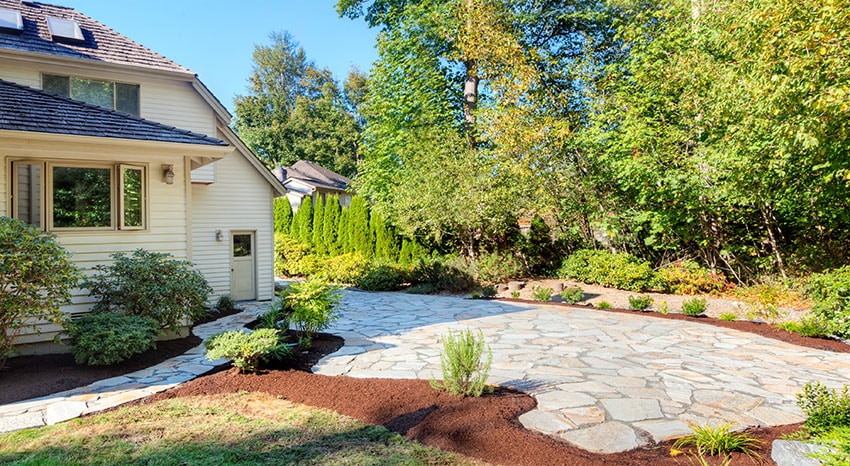
Flagstone patios instantly create variation in texture and color, giving more depth and dimension to a space.
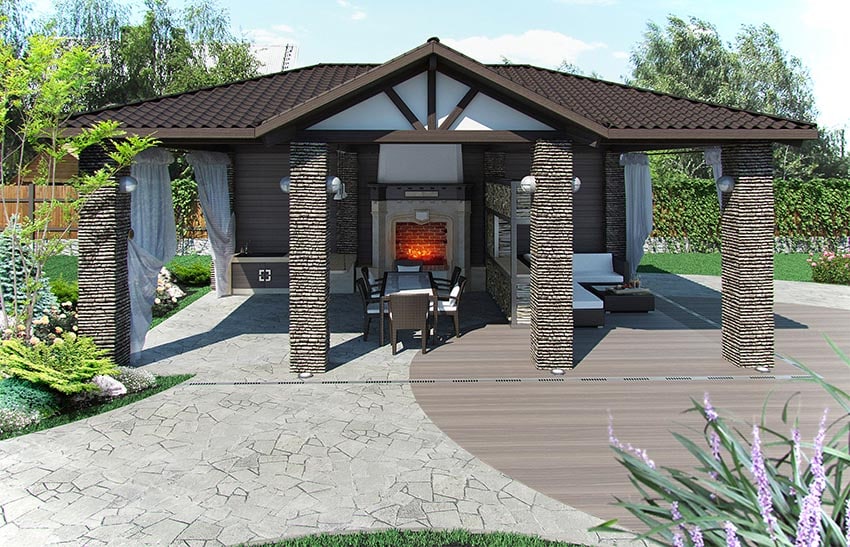
The picture above shows a modern take on a flagstone patio, wherein stone pieces are set at a closer and tighter pattern. Outdoor floor tiles are mixed with irregularly cut natural stones to create a stunning visual impact.
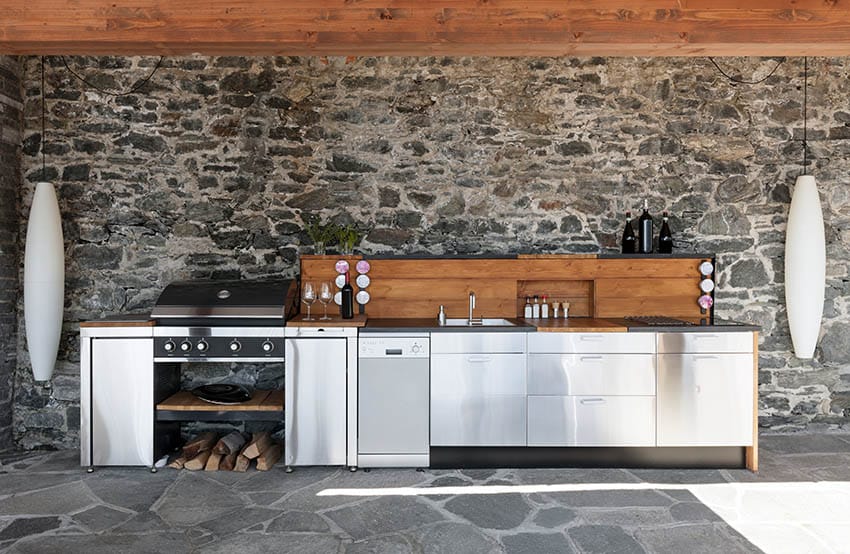
This modern outdoor kitchen is accentuated with a coarse stone wall and mosaic-patterned basalt flagstones. The sleek, streamlined look of stainless steel kitchen cabinets and accessories creates a stark contrast with the accent stones, proving that modern and traditional elements can be fused.
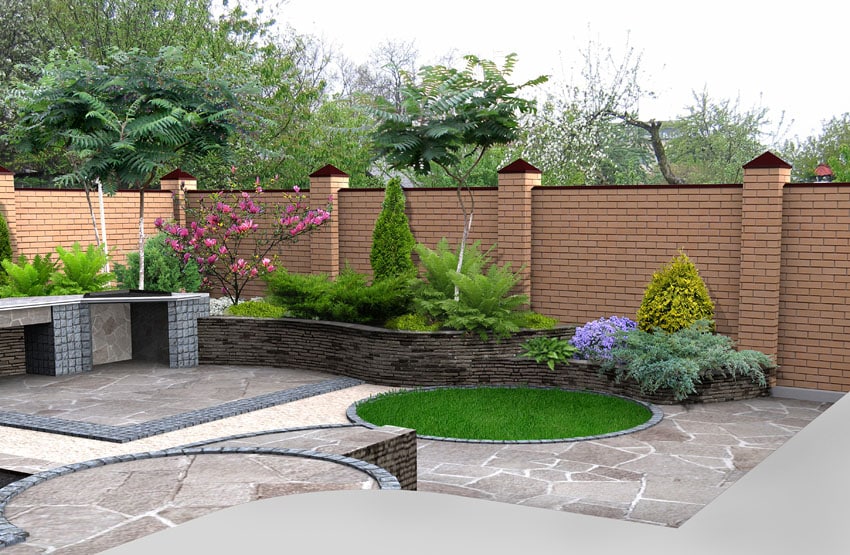
Concrete designed to look like flagstones
Concrete is a good alternative for simulating the look of natural stone materials. This modern minimalist patio features accent stones for the plant’s borders, a brick wall, and concrete pavers. Well-groomed or shaped foliage is incorporated into the design to match the clean lines of this patio. See more paving stone patio designs here.
Flagstone Layout with Fire Pit
The addition of a fire pit in your flagstone patio will enable you to enjoy specific activities anytime, whether to enjoy a nice grill out in the backyard with friends or to catch warmth during a cold night.
A fire pit is pretty easy to install. It is comprised mainly of stones interlocked to form a circular shape. These layers of stones are usually 3 to 4 full courses high and are joined by mortar.
Outdoor fire pits are usually built-in or incorporated within the patio design, making it a functional central feature. In terms of design, walls for a fire pit are usually matched with the paver flooring for patios to create fluidity.
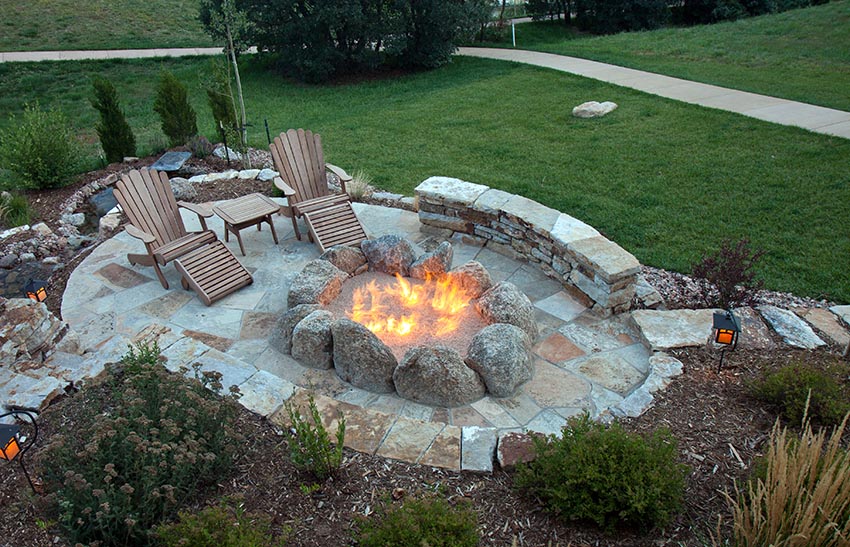
This quartzite flagstone patio features a relaxing DIY stone firepit at the center, surrounded by wooden lounge chairs, a rustic garden, and a verdant lawn.
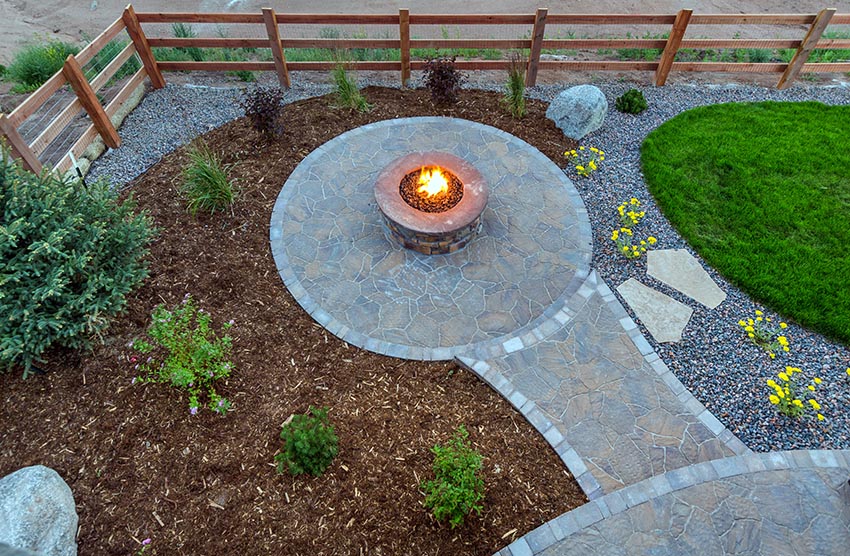
This round flagstone patio extends to the walkway and is encompassed with bark, pea gravel and grass. From a full view, we can see how space is clearly defined through changes in flooring material. Aside from that, the variation in texture and color also adds a creative play of design elements.
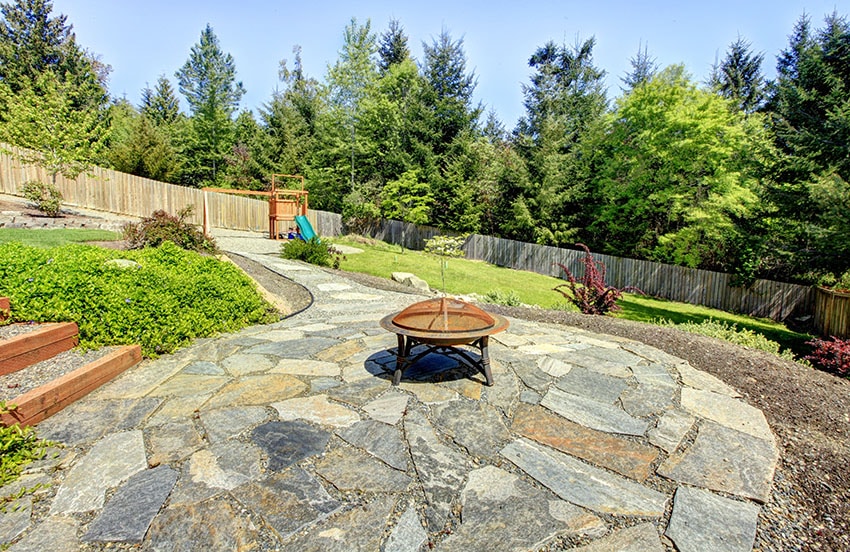
This rustic flatstone patio has large irregular gray and tan colored natural stones with pea gravel fillers. It also features a portable fire pit, an ideal option for homeowners who do not want to incorporate a built-in version at the center of their patios.
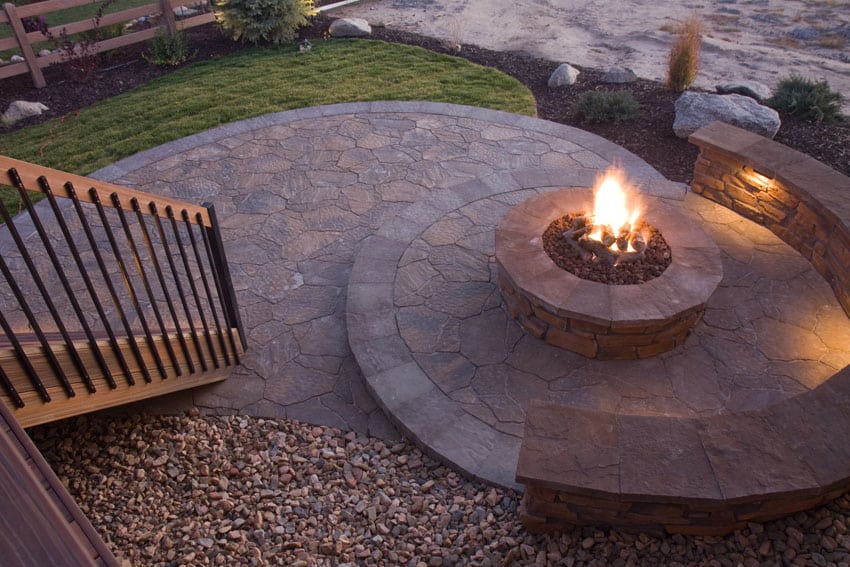
This concrete and natural flatstone patio has a built-in fire pit with a curved bench – a perfect spot to end a long day of work and a relaxing retreat to spend cold nights with friends and family.
Small Flagstone Backyard Ideas
Flagstones are a stunning addition to any outdoor space, whether small or big. If dealing with small patios, choose larger flagstones and keep spacing tighter, as it tends to create an illusion of continuous flooring. Also, select lighter colors for the flatstone to make the space appear bigger.
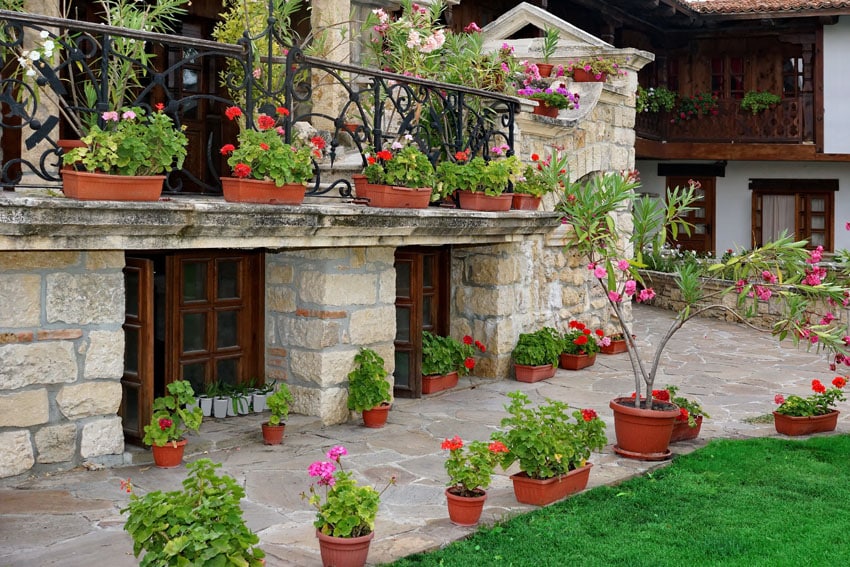
This charming old-world-style villa features a natural beige limestone paving stone patio and limestone exteriors. Blushing blooms of flowers are added to soften the look and tone of this space’s architectural components.
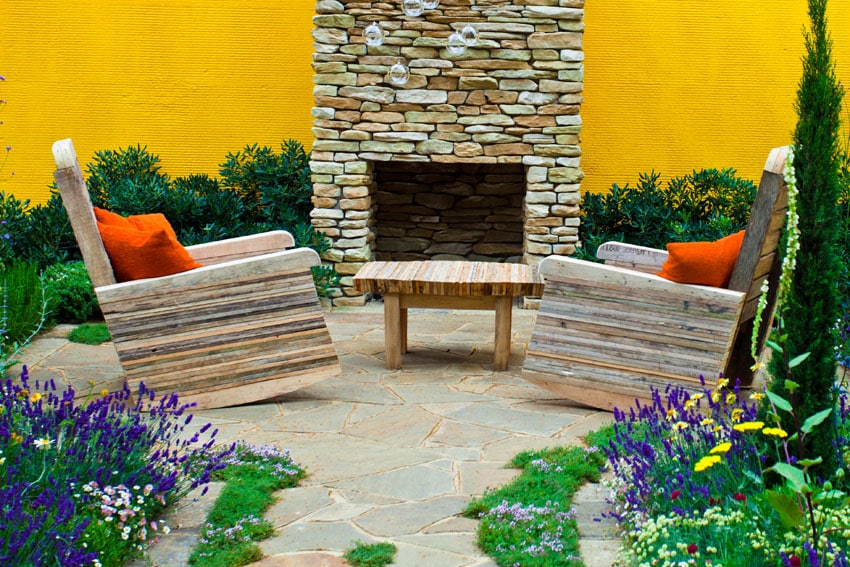
This paving stone patio design features natural stone pavers, a stacked stone fireplace, and rustic wooden rocking chairs with a matching table. Beautifully tucked at the corner of this flourishing garden, this space exudes charm and rustic flair. This “Do it Yourself” flagstone patio features sandstone pavers and a natural flower garden border. The light color of the materials is a perfect match for the stacked stone fireplace. For more designs, visit this page to see our gallery of beautiful patio ideas.


